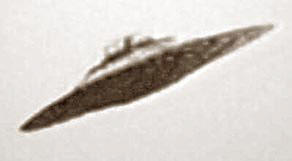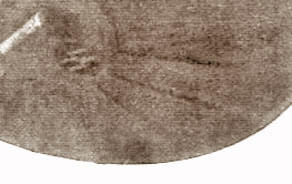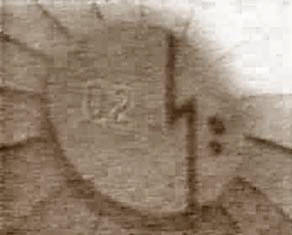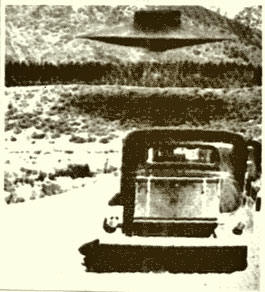Vril 1 "Jager (Hunter)"
(1941)
The Vril motto “Not all good comes from above” summarizes the entire
history of the Vril Gesellschaft (Society) from its inception to the
final days of WW2 when this occult group seemed to vanish right off the
face of the earth.
The name Vril is the shortening of “VRI-IL” which means “Like God”.
Officially Vril was “The All German Society for Metaphysics” which
merged with the Thule Gesellschaft and the obscure DHvSS (Men of the
Black Stone) in the year 1919.
Each occult group had its own distinct beliefs and origins. The
DHvSS
(1912) worshipped the German mountain goddess Isias and the Schwarz
Stein (black stone). The Thule Gesellschaft (1917) believed in the
hollow earth theory and derived its name from
Ultima Thule the ancient
capital of Hyperborea at the top of the world. Vril worshipped
the Black
Sun (the invisible inner light of the Godhead) which supposedly gave or
generated incredible power and communicated with Aryan aliens through
psychic channeling.
But unlike the other two groups the Vril Gesellschaft were an inner
circle of women who were also fighting against their times and culture.
They were psychic mediums that wore a horse-tail hairstyle. They
believed that their long hair acted as cosmic antennae to receive alien
communication from beyond. So this is where the Vril disc story begins.
Despite their distrust of men, the women of Vril joined with the
Thule Gesellschaft and DHvSS in order to construct an inter-dimensional
channeled flight disc known as the JenseitsFlugMaschine (JFM). By 1922
the odd disc shaped machine was constructed in Munich and tested for two
years. It is not known if any success with channeled flight was ever
achieved but a certain W.O. Schumann of the Technical University of
Munich invented a levitator from the channeled JFM information provided
by the mediums Maria Orsic and Sigrun. By 1924 the JFM project was
scrapped but work continued on perfecting the levitator unit known by
then as the Schumann SM-Levitator.
With the Nazi Party in power in 1933 (which itself originated from the
Thule Gesellschaft) the occultists now received official backing for
their continued development of the flight discs. Thule and Vril started
with the RFZ (RundFlugZeug, or Round Aircraft) series from 1934-41.
As war had started in 1939 the RFZ-5 became the Haunebu I and by 1941
the RFZ-7 had become the Vril 1 Jager (Hunter). The reason for the
changes were due to Thule’s revolutionary Triebwerk (Thrustwork) engine
that used rotating electro-magnetic-gravitic fields to affect gravity.
Vril had by 1941 perfected the SM-Levitator as well and thus two new
series entered limited construction, but with slightly different goals.
Thule wanted to develop both a production combat craft and a functional
Raumschiff (Spaceship). Vril, by comparison, only wanted to develop
Raumschiffen to reach Aldebaran in the Taurus Constellation 68 light
years from earth.
As Hitler had forbid secret societies in Germany from 1941 forward, both
Thule and Vril were documented under the SS Technical Branch Unit E-IV (Entwicklungsstelle
4) tasked with developing alternative energies. This unit had already
helped with the RFZ series but now “officially” Thule and Vril did not
exist. Vril became known secretly as “the chain”. Vril members wore a
Doppelsignet disc that represented the two mediums Maria Orsic and
Sigrun.
The first purely Vril disc - the Vril 1 Jager (Hunter) was constructed in
1941 and first flew in 1942. It was 11.5 meters in diameter, had a
single pilot, and could achieve 2,900 km/h - 12,000 km/h! It flew with a
metal dome at first but subsequent test versions had a heavily
reinforced glass dome and could seat two crew. Flight endurance was 5.5
hrs. It was planned to arm this craft with two MK-108 cannon plus 2
MG-17 machineguns. Seventeen of these craft were constructed and tested
between 1942-44 with 84 test flights
The Vril 2 Zerstorer (Destroyer) was a highly advanced oval shaped disc
that was much too complex for the time period; thus it was projected for
1945/46, so no construction was started. The Vril 3 and 4 have been
photographed but no surviving information is found on them. Vrils 5 and
6 likewise do not show up and may have only been projects. The Vril 7
and 8, however, were constructed.
The Vril 7 Geist (Ghost) was 45 meters in diameter and crewed by
fourteen men. It was built in 1944 and tested at Arado-Brandenburg using
Vril‘s own Triebwerk.
Vril’s medium Sigrun made frequent trips to the facility to oversee
construction and testing. In 1944, Arado engineers approached her with a
request. They wanted to know if the Vril Triebwerk could be adapted to
one of their projects- the Arado E.555 strategic bomber. They were
abruptly told , “No” and returned to their designs which resulted in
eleven different versions of the bomber.
Sigrun was actually insulted because the entire purpose of the Vril
discs was aimed at space flight. No conventional bomber could withstand
the heat of the velocity achieved by these machines which were
constructed of hulls specially made of an advanced metal called
Viktalen
(in some sources Victalen or Viktalon). The Vril 1 had a single hull of
this type, the Vril 7 two. The large Haunbeu III had three!
With the SS supervising all aspects of the disc programs every model had
to have at least theoretical provision for armament. In the Vril 7 Geist
it would have been four MK-108 cannon.
The Vril 8 Odin was the last official Vril disc that was flight tested
in the spring of 1945 during the collapse. This disc had an automatic
Oberon upward-firing gun installation on top of the control center.
The Vril Gesellschaft had started evacuating to Base 211 in
Neu
Schwabenland Antarctica in March 1945 so it would seem like the
Vril 8
Odin was the last Vril disc actually tested. However, some weeks after
Germany surrendered both Haunebu and Vril craft were spotted in the
skies over occupied Germany. Although the Vril 9 Abjager (Universal
Hunter) was show as a design on paper, a craft identical to it was
photographed postwar.
Vril’s final plan was the construction of a large 139 meter long
cylindrical Raumschiff known by the SS E-IV Unit as the Andromeda-Gerat.
Work on this “flying cigar” was to commence in 1945 at a huge, sheltered
above-ground Zeppelin-like hangar. Once completed it could internally
accommodate one large Haunebu IV and two Vril 2 craft, making the
journey to Aldebaran, the ultimate dream of the Vril Gesellschaft.
Although these mysterious craft seem to come from the realm of science
fiction it is interesting to note that once Germany was occupied and the
military Intel teams swept through the defeated nation all documentation
and evidence of the Vril Gesellschaft was destroyed by the Allies. If
the occult Society and craft never existed and did not represent any
threat to the Allies then why has all trace of their existence been
forcefully carried out by the victors?
“Not all good comes from above”. For Vril it came “from beyond… 68 light
years from earth” and it was this obsession that lead to ALL of the
occult German disc programs. One can only wonder if any of them truly
made it to their ultimate destination?
Rob Arndt




















